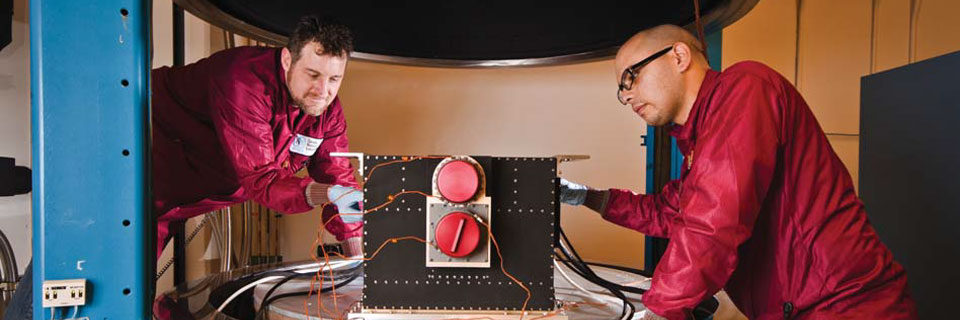
The Global Burst Detector completed a major program milestone in November 2014 by gaining customer approval to ship the third flight system to the GPS III space vehicle contractor for integration. The Global Burst Detector, hosted on the GPS satellite, provides 24/7 Medium Earth Orbit detection and location of nuclear detonation events worldwide and builds on the successful deployment of the GPS IIF and IIR suite of satellites currently on orbit. Sandia, in partnership with Los Alamos National Laboratory, has a long history in the development and delivery of satellite based nuclear detonation detection systems. (2600, 5300, 5700) DSA [NAW]
Recognizing Sandia’s in-depth expertise in remote sensing science and operations, the US Air Force Space Command engaged the Labs to participate in the Space-Based Infrared System (SBIRS) Follow-On Analysis of Alternatives (AOA). The AOA will determine the most cost-effective approach for performing our nation’s missile warning, missile defense, and battle space awareness missions against emerging targets and technologies beyond the current SBIRS program. By guiding design options and simulating mission performance of alternatives, the DS&A PMU is helping shape the next-generation DoD space architecture. (5000, 5500, 5300, 05700, 10600) DSA [LDI]
Sandia successfully completed security design and installation upgrades at a critical location. The upgrade included a Wide Area Surveillance System and Intrusion Detection and Assessment System. Working in partnership with US Air Force and under direction from the Joint Theatre Surety Management Group, Sandia met all requirements on time and within budget, and this site passed Government Acceptance Testing in July 2014. Sandia has been involved in protecting our nation’s critical assets for more than 40 years. (6500) IHNS [RGND]
Sandia’s Space Mission Program has received authority for a major initiative to develop and deliver a next-generation satellite ground system. This ground system, building on Sandia’s successful history, will support generalized and extensible mission management and data processing for a new breed of persistent sensors developed by industry. The system will enable robust research and development of technologically advanced algorithms and quickly deploy them to meet rapidly changing needs of end users. (5500, 10600) DSA [LDI]
Along with a number of Sandia partner organizations, the Advanced Systems Program delivered a major update to a sensing ground station software system. This was the largest delivery since the original ground system delivery and concluded an 18-month development and delivery effort that resulted in the installation of three million lines of code, eight racks of computer and network hardware, and a number of significant new system capabilities. The installation effort was accomplished with just hours of system down-time, delighting the customer. (2600, 5300, 5500, 9500, 10600) DSA [LDI]
Sandia’s Airborne Intelligence Surveillance and Reconnaissance Systems group successfully integrated the Copperhead synthetic aperture radar onto a new platform, the US Army’s Hunter unmanned aerial vehicle. This quick-turn technical effort was completed in approximately four months as required to support a transition directed by the deputy secretary of defense. The successful effort was critical in extending the Copperhead Counter-IED mission through FY15. (5300, 2600, 5400) DSA [SDP]